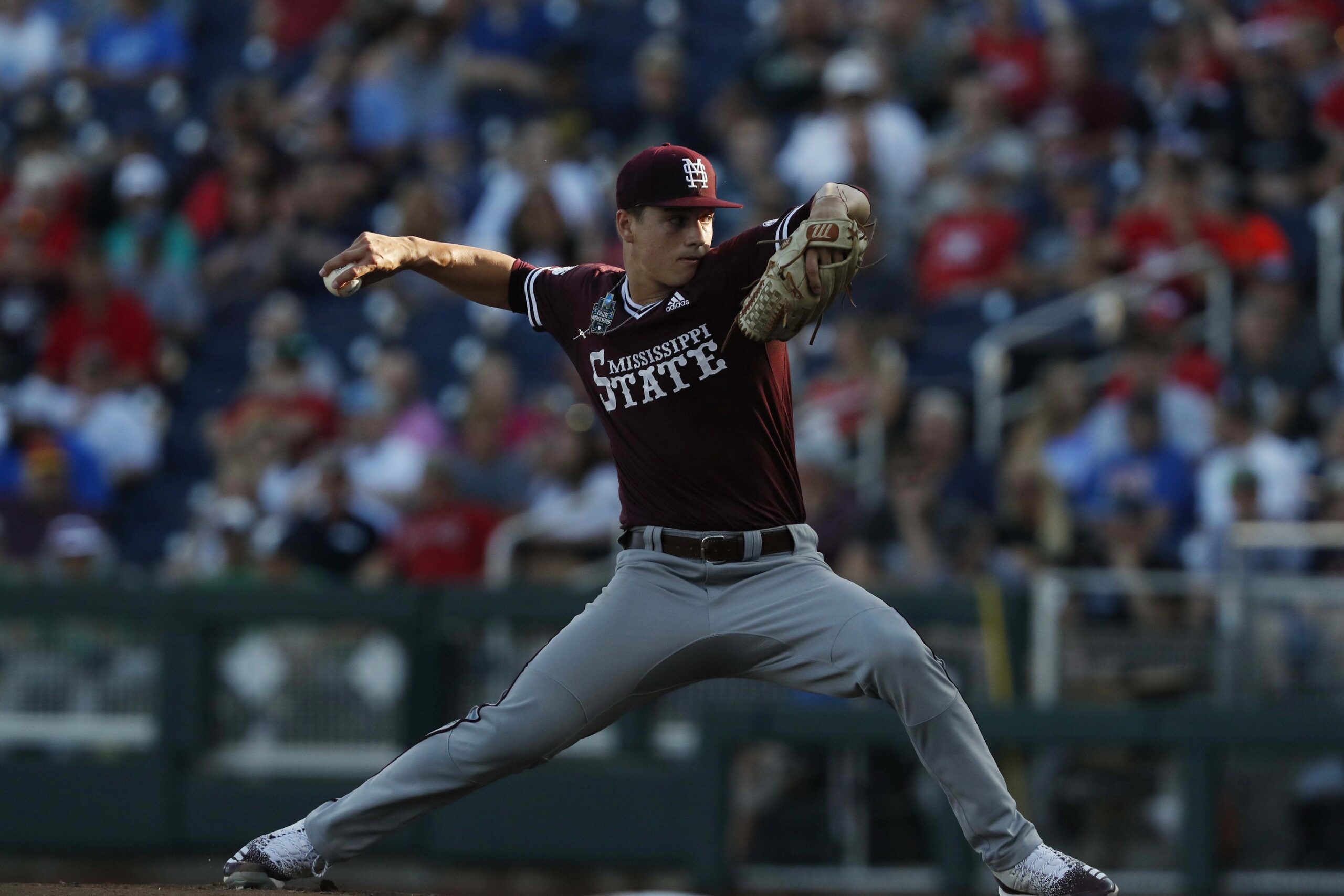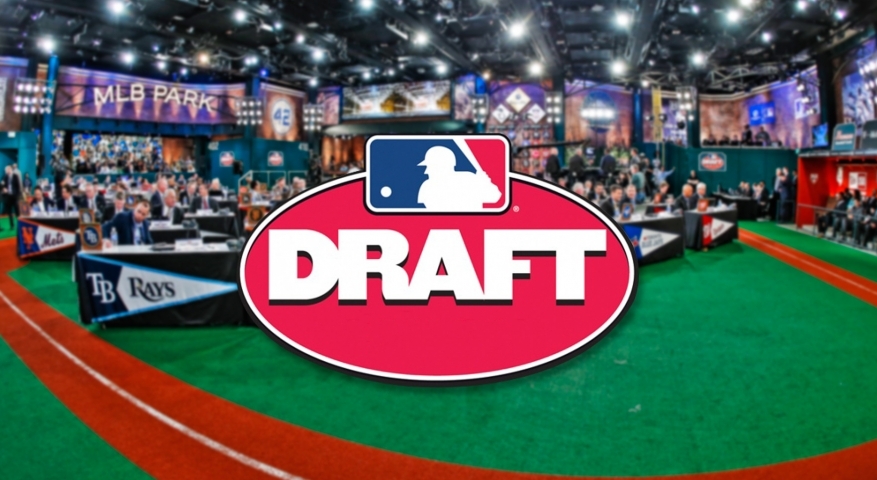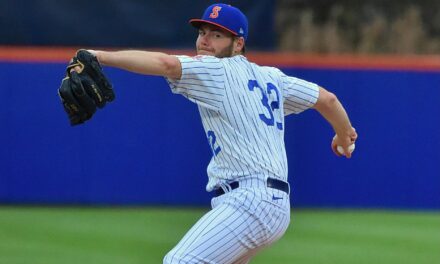
The New York Mets are slated to have the No. 19 pick in the 2020 MLB Draft. That’s been a very good spot the last five years. Three of the players selected with that pick since 2015 have been top 100 prospects and two of them are top 50. The two who weren’t top 100 prospects were standout Pittsburgh Pirates rookie Kevin Newman and 2019 selection Zack Thompson.
The Mets were a part of that impressive run on selections with the 19th pick. They selected top-100 prospect Justin Dunn with the 19th pick of the 2016 MLB Draft. Dunn has since been traded to the Seattle Mariners as part of the Edwin Diaz and Robinson Cano trade.
It’s still incredibly early to talk about the MLB Draft. Prep prospects pop up in the spring out of nowhere every year, while highly touted college players fall off completely. For instance, Brett Baty wasn’t a top 30 prospect on MLB.com’s original January list last year and he went 12th overall after a break out campaign. Conversely, Kameron Misner was a top 15 prospect who had a horrible year and fell to the No. 35 pick.
Those may not seem like major shifts, but they are for prospects considered elite in their class. For a more stark switch look no further than Mets 2019 second round pick Josh Wolf. Wolf wasn’t even in the top 100 prior to the season, then he saw his velocity jump. He caught the attention of scouts and was taken with the 53rd pick.
With that in mind, here’s an early look at four players who could make sense for the New York Mets with the 19th pick.
J.T. Ginn, RHP, Mississippi State
Ginn (pictured above) was the Dodgers’ first-round selection in the 2018 MLB Draft. He was not able to come to an agreement with them and opted to take his talents to Mississippi State. The right-hander’s decision has born some incredible results.
Ginn has one of the best fastballs in the class. It sits mid-90’s and gets as high as 98 mph with late sink that makes it nearly impossible for hitters to barrel the ball. His slider has also developed into a plus pitch with two plane drop. It’s not an elite slider because the pitch only sits mid-80’s. However, when he has it going, his slider deals with both lefties and righties with ease.
Ginn’s worst pitch is his changeup. Even that is an above-average pitch that flashes plus, however. The sink the pitch has is good, but it’s held back by its low 80’s velocity, which isn’t far off from his slider, and it’s ineffectiveness against righties.
Ginn’s control was phenomenal as a freshman. He walked just 19 batters in over 86 innings last season while striking out 103. That improved control comes from a more smooth delivery. He’s fixed the mechanical issues that he had as a high schooler and looks much more comfortable on the mound.
Ginn is on the smaller side, standing at 6-foot-2 and 192 lbs. He’s not small enough to give teams concern, but his size has been questioned before. It wouldn’t be surprising if teams view him more as a bullpen piece than a starter. His size and three-pitch mix scream elite closer. It doesn’t help that Ginn was limited in the second half of last season with arm soreness.
If not for the size and questions about his durability, Ginn would likely be a top 10 pick. It’s still possible he is if he’s able to calm those concerns with a strong showing this season. As things stand now though, Ginn is a realistic and exciting potential option for the Mets at 19.
Zac Veen, OF, Spruce Creek (Fla.) HS
Veen burst onto the scene during the summer of 2019. He’s drawn comparisons to Cody Bellinger and Kyle Tucker from a raw tools standpoint. That said, it’s hard to see him reaching that ceiling.
Veen’s left-handed swing is clean and crisp. He’s a line-drive hitter who sprays the ball to all fields. He runs into issues when he tries to swing for power, however. He begins to swing with an uppercut that leads to big strikeout numbers and really hurts his contact ability.
For that reason, Veen’s power and hit tool have been under constant debate. Some think Veen’s power will translate more naturally as he ages and his body fills out. Others don’t see anything more than 15 home run power.
Veen’s size is a scouts’ dream at 6-foot-4 and 190 pounds. There’s plenty of room for Veen to grow into his body and add muscle. That’s also why scouts question his ability to stick in center field. It’s likely that as he continues to grow Veen will lose his speed and have to move to a corner spot. Considering his arm strength left field is the likely future home for Veen.
At his best, Veen could develop into an all-around plus hitter with average left field defense. At his worst, he’ll be a high variance offensive player whose defense won’t be good enough to carry his inconsistent bat.
Pete Crow-Armstrong, OF, Harvard-Westlake (Cal.) HS
This time last year, Crow-Armstrong was a lock to be a top five pick. After a disappointing showing in his junior year, he’s fallen almost out of the first round. However, the tools that made Crow-Armstrong an elite prospect at an early age are still there.
Crow-Armstrong still has his plus-plus speed and his elite defense in center field. He’s the best defensive outfielder in this prep class without question. His speed will also provide 30+ stolen base potential at the next level.
The question is how much the bat will improve. Crow-Armstrong has a smooth lefty swing that sprays the ball to all fields. His speed helps him take advantage of his spray hitting, often turning single into doubles with his speed. The issue is he lacks power and he’s trying too hard to compensate for it.
Crow-Armstrong got the attention he did because of his hit tool and his speed. He looked like an old-school leadoff hitting center fielder with elite defensive potential. Now his search for power has added holes to his swing creating swing-and-miss potential that scares teams.
Crow-Armstrong’s 6-foot-1 and 175-pound frame offers hope for more developing power, but not much. It’s likely Crow-Armstrong will never be anything more than a 10-15 home run hitter at his peak.
If he can accept that and his hit-tool hits his ceiling, Crow-Armstrong could look a lot like Atlanta Braves center fielder Ender Inciarte.
Max Meyer, RHP, Minnesota
Meyer is one of the most interesting prospects in this class. He was one of the best relievers in the NCAA during his freshman year. Then last season, the Golden Gophers moved him to the starting rotation, as they were desperate for pitching. Meyer responded by pitching to 2.11 ERA with 2.5 BB/9 and 10.2 K/9. He improved that after the season when he led the USA Collegiate National Team with a 0.69 ERA.
He’s also got the best stuff two-pitch mix of any pitcher in this class. Meyer’s fastball sits 93-95, touching 98 out of the bullpen. Its movement isn’t as good as Ginn’s but it has enough life that it’s easily a plus pitch. Where Meyer really shines is his slider. His slider is an elite pitch, and the best breaking pitch in this draft class. His slider sits 87-91 with sharp break that he controls at will.
His changeup is a developing pitch. It works well coming out of the bullpen, but as a starter, it’s mostly used as change-of-pace pitch more than anything else. If he improves his changeup to be a viable third pitch, the sky’s the limit for Meyer.
At this point, you’re probably asking what the question is with him. If Meyer’s so great how could be available for the Mets at No. 19? Well, he has one fatal flaw that MLB teams often fail to overlook, his size. Meyer is just six-foot and 185 pounds, and he’s never thrown 80 innings. Teams have real concerns about his ability to start. Even if Meyer ends up in the bullpen, he will be an elite back-end guy who likely shoots through the farm system. It wouldn’t be surprising if he’s the first player to reach the majors form this class.
If he can prove his durability and throw over 100 innings this season at a high level there’s no doubt he’s off the board before he gets to Mets. However, if he gives teams even one reason to doubt his starting potential he could slide to the Mets, just like Justin Dunn did in 2016.














